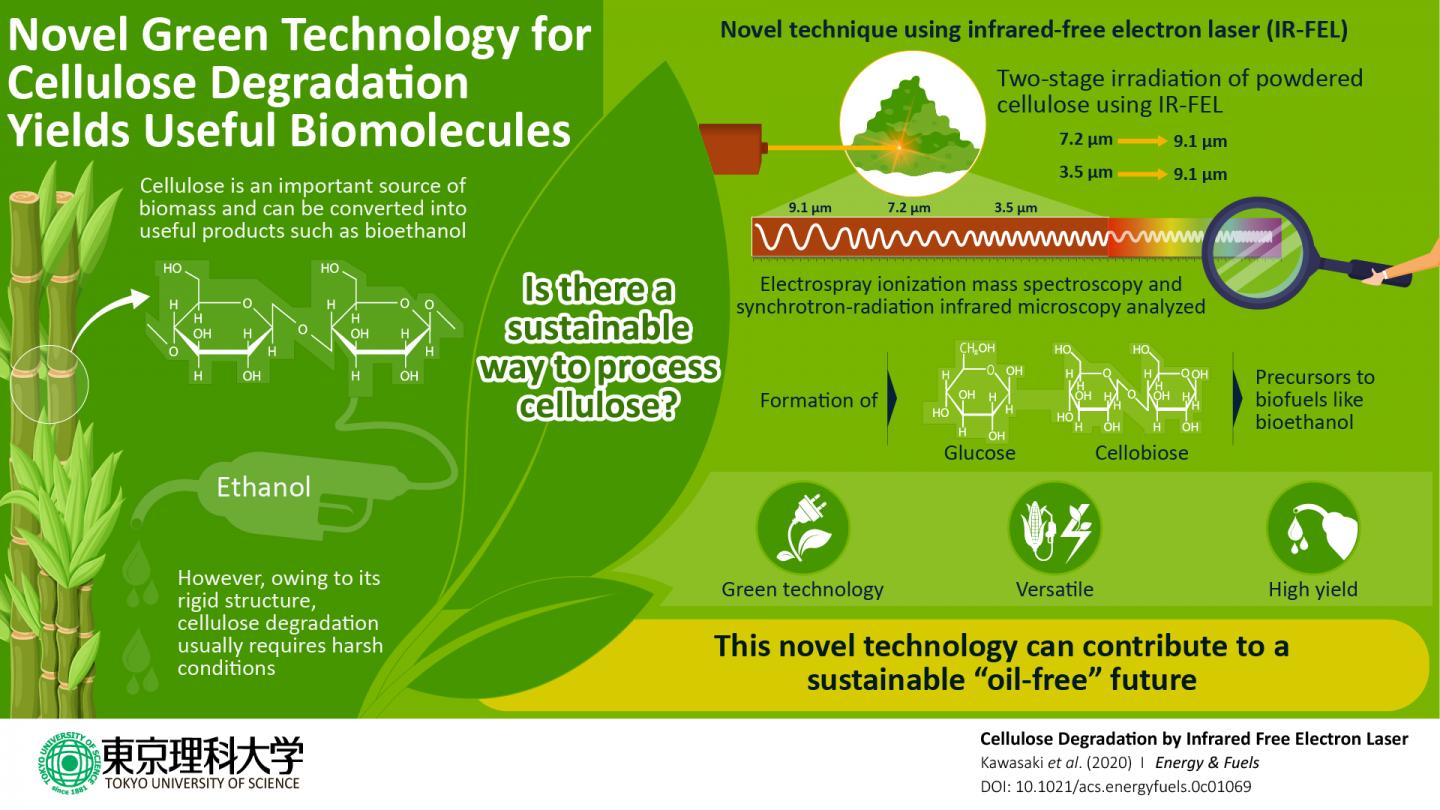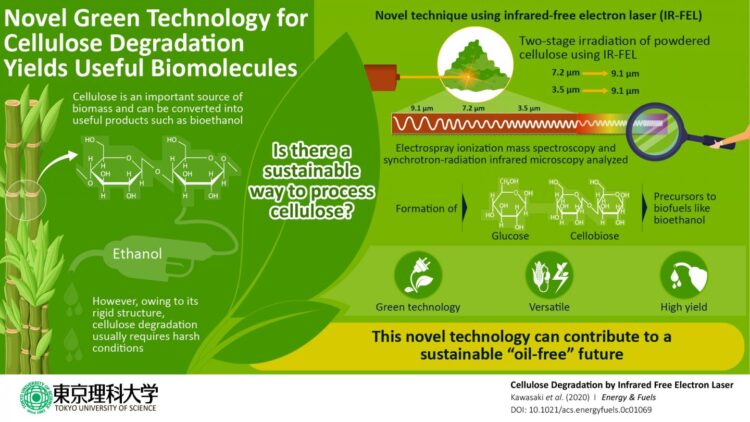Scientists developed a novel laser-based strategy for the effective degradation of cellulose into useful products

Credit: Tokyo University of Science
With the imminent threat of a climate crisis hanging over our heads, it has become crucial to develop efficient alternatives to fossil fuels. One option is to use clean sources of fuels called biofuels, which can be produced from natural sources such as biomass. The plant-based polymer cellulose is the most abundant form of biomass globally and can be converted into raw materials such as glucose and xylose for the production of bioethanol (a type of biofuel). But, this process is challenging owing to the molecule’s rigid and dense structure, which makes it insoluble in water. Chemists and biotechnologists globally have used conventional techniques like microwave radiation, hydrolysis, and ultrasonication to degrade this polymer, but these processes require extreme conditions and are thus unsustainable.
To this end, in a new study published in Energy & Fuels, a research team in Japan, including Dr Takayasu Kawasaki (Tokyo University of Science), Dr Heishun Zen (Institute of Advanced Energy, Kyoto University), Prof Yasushi Hayakawa (Laboratory of Electron Beam Research and Application, Institute of Quantum Science, Nihon University), Prof Toshiaki Ohta (SR Center, Ritsumeikan University), and Prof Koichi Tsukiyama (Tokyo University of Science), developed a novel technique for cellulose degradation. This technique was based on a type of laser called the infrared-free electron laser (IR-FEL), whose wavelength is tunable in the range of 3 to 20 μm. This new method is a promising green technology for the zero-emission degradation of cellulose. Dr Kawasaki says, “One of the unique features of the IR-FEL is that it can induce a multiphoton absorption for a molecule and can modify the structure of a substance. So far, this technology has been used in the basic fields of physics, chemistry, and medicine, but we wanted to use to spur advances in environmental technology.”
The scientists knew that IR-FEL could be used to perform dissociation reactions on various biomolecules. Cellulose is a biopolymer composed of carbon, oxygen, and hydrogen molecules, which form covalent bonds of varying lengths and angles with each other. The polymer has three infrared bands at the wavelengths of 9.1, 7.2, and 3.5 μm, which correspond to three different bonds: the C?O stretching mode, H?C?O bending mode, and C?H stretching mode, respectively. Based on this, the scientists irradiated powdered cellulose by tuning the wavelength of the IR-FEL to these three wavelengths. Then, they analyzed the products using techniques such as electrospray ionization mass spectrometry and synchrotron radiation infrared microscopy, which revealed that the cellulose molecules had successfully decomposed into glucose and cellobiose (precursor molecules for bioethanol production). Not just this, their products were obtained at high yields, making this process extremely efficient. Dr Kawasaki explains, “This was the first method in the world to efficiently obtain glucose from cellulose by using an IR-FEL. Because this method does not require harsh reaction conditions such as harmful organic solvents, high temperature, and high pressure, it is superior to other conventional methods.”
Apart from generating biofuels, cellulose has several applications–for example, as functional biomaterials in biocompatible cell membranes, antibacterial sheets, and hybrid paper materials. Thus, the new method developed in this study shows promise for various industries, such as healthcare, technology, and engineering. Moreover, Dr Kawasaki is optimistic that their method is useful to process not only cellulose but also other wood constituents and can prove to be an innovative method for recycling forest biomass. He concludes, “We hope that this study will contribute to the development of an ‘oil-free’ society.”
###
About The Tokyo University of Science
Tokyo University of Science (TUS) is a well-known and respected university, and the largest science-specialized private research university in Japan, with four campuses in central Tokyo and its suburbs and in Hokkaido. Established in 1881, the university has continually contributed to Japan’s development in science through inculcating the love for science in researchers, technicians, and educators.
With a mission of “Creating science and technology for the harmonious development of nature, human beings, and society”, TUS has undertaken a wide range of research from basic to applied science. TUS has embraced a multidisciplinary approach to research and undertaken intensive study in some of today’s most vital fields. TUS is a meritocracy where the best in science is recognized and nurtured. It is the only private university in Japan that has produced a Nobel Prize winner and the only private university in Asia to produce Nobel Prize winners within the natural sciences field. Website: https:/
Dr Takayasu Kawasaki from Tokyo University of Science
Dr Takayasu Kawasaki is a researcher at the Infrared Free Electron Laser Research Center at the Tokyo University of Science (FEL-TUS). He is specialized in the area of bioorganic chemistry and materials science. A respected and senior researcher, he has more than 20 research articles published in prestigious international journals to his credit.
Funding information
This research was supported in part by the Open Advanced Research Facilities Initiative and Photon Beam Platform Project of the Ministry of Education, Culture, Sports, Science, and Technology of Japan. This research was also conducted by a joint use research with Institute of Advanced Energy, Kyoto University (Joint Usage/Research Program on Zero-Emission Energy Research, ZE31A-12), SR center, Ritsumeikan University (S19001), and Laboratory of Electron Beam Research and Application, Institute of Quantum Science, Nihon University.
Media Contact
Tsutomu Shimizu
[email protected]
Related Journal Article
http://dx.





